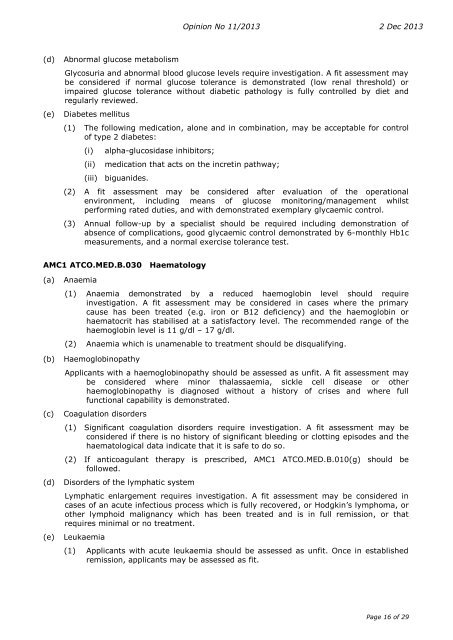AMC & GM to Part ATCO.MED - EASA
AMC & GM to Part ATCO.MED - EASA
AMC & GM to Part ATCO.MED - EASA
You also want an ePaper? Increase the reach of your titles
YUMPU automatically turns print PDFs into web optimized ePapers that Google loves.
Opinion No 11/2013 2 Dec 2013<br />
(d)<br />
(e)<br />
Abnormal glucose metabolism<br />
Glycosuria and abnormal blood glucose levels require investigation. A fit assessment may<br />
be considered if normal glucose <strong>to</strong>lerance is demonstrated (low renal threshold) or<br />
impaired glucose <strong>to</strong>lerance without diabetic pathology is fully controlled by diet and<br />
regularly reviewed.<br />
Diabetes mellitus<br />
(1) The following medication, alone and in combination, may be acceptable for control<br />
of type 2 diabetes:<br />
(i)<br />
(ii)<br />
alpha-glucosidase inhibi<strong>to</strong>rs;<br />
medication that acts on the incretin pathway;<br />
(iii) biguanides.<br />
(2) A fit assessment may be considered after evaluation of the operational<br />
environment, including means of glucose moni<strong>to</strong>ring/management whilst<br />
performing rated duties, and with demonstrated exemplary glycaemic control.<br />
(3) Annual follow-up by a specialist should be required including demonstration of<br />
absence of complications, good glycaemic control demonstrated by 6-monthly Hb1c<br />
measurements, and a normal exercise <strong>to</strong>lerance test.<br />
<strong>AMC</strong>1 <strong>ATCO</strong>.<strong>MED</strong>.B.030 Haema<strong>to</strong>logy<br />
(a)<br />
(b)<br />
(c)<br />
(d)<br />
(e)<br />
Anaemia<br />
(1) Anaemia demonstrated by a reduced haemoglobin level should require<br />
investigation. A fit assessment may be considered in cases where the primary<br />
cause has been treated (e.g. iron or B12 deficiency) and the haemoglobin or<br />
haema<strong>to</strong>crit has stabilised at a satisfac<strong>to</strong>ry level. The recommended range of the<br />
haemoglobin level is 11 g/dl – 17 g/dl.<br />
(2) Anaemia which is unamenable <strong>to</strong> treatment should be disqualifying.<br />
Haemoglobinopathy<br />
Applicants with a haemoglobinopathy should be assessed as unfit. A fit assessment may<br />
be considered where minor thalassaemia, sickle cell disease or other<br />
haemoglobinopathy is diagnosed without a his<strong>to</strong>ry of crises and where full<br />
functional capability is demonstrated.<br />
Coagulation disorders<br />
(1) Significant coagulation disorders require investigation. A fit assessment may be<br />
considered if there is no his<strong>to</strong>ry of significant bleeding or clotting episodes and the<br />
haema<strong>to</strong>logical data indicate that it is safe <strong>to</strong> do so.<br />
(2) If anticoagulant therapy is prescribed, <strong>AMC</strong>1 <strong>ATCO</strong>.<strong>MED</strong>.B.010(g) should be<br />
followed.<br />
Disorders of the lymphatic system<br />
Lymphatic enlargement requires investigation. A fit assessment may be considered in<br />
cases of an acute infectious process which is fully recovered, or Hodgkin’s lymphoma, or<br />
other lymphoid malignancy which has been treated and is in full remission, or that<br />
requires minimal or no treatment.<br />
Leukaemia<br />
(1) Applicants with acute leukaemia should be assessed as unfit. Once in established<br />
remission, applicants may be assessed as fit.<br />
Page 16 of 29
















